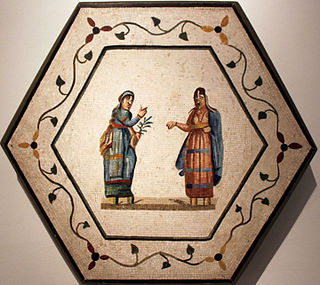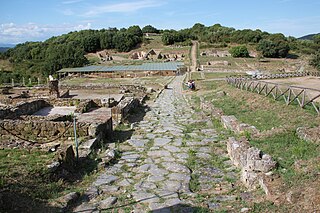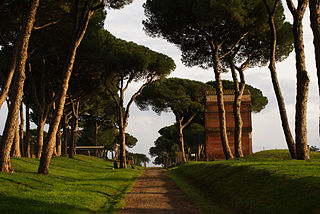
Tivoli is a town and comune in Lazio, central Italy, 30 kilometres north-east of Rome, at the falls of the Aniene river where it issues from the Sabine hills. The city offers a wide view over the Roman Campagna.

Sant'Andrea della Valle is a minor basilica in the rione of Sant'Eustachio of the city of Rome, Italy. The basilica is the general seat for the religious order of the Theatines. It is located at Piazza Vidoni, at the intersection of Corso Vittorio Emanuele and Corso Rinascimento.

The Chigi Chapel or Chapel of the Madonna of Loreto is the second chapel on the left-hand side of the nave in the Basilica of Santa Maria del Popolo in Rome. It is the only religious building of Raphael which has been preserved in its near original form. The chapel is a treasure trove of Italian Renaissance and Baroque art and is ranked among the most important monuments in the basilica.

Borgo is the 14th rione of Rome, Italy. It is identified by the initials R. XIV and is included within Municipio I.

The Parish Basilica of Santa Maria del Popolo is a titular church and a minor basilica in Rome run by the Augustinian order. It stands on the north side of Piazza del Popolo, one of the most famous squares in the city. The church is hemmed in between the Pincian Hill and Porta del Popolo, one of the gates in the Aurelian Wall as well as the starting point of Via Flaminia, the most important route from the north. Its location made the basilica the first church for the majority of travellers entering the city. The church contains works by several famous artists, such as Raphael, Gian Lorenzo Bernini, Caravaggio, Alessandro Algardi, Pinturicchio, Andrea Bregno, Guillaume de Marcillat and Donato Bramante.

Lorium was an ancient village of ancient Etruria, Italy, on the Via Aurelia, 19 km west of Rome, near today's Castel di Guido.

Rusellae was an important ancient town of Etruria, which survived until the Middle Ages before being abandoned. The impressive archaeological remains lie near the modern frazione or village of Roselle in the comune of Grosseto.

The Temple of Apollo Sosianus is a Roman temple dedicated to Apollo in the Campus Martius, next to the Theatre of Marcellus and the Porticus Octaviae, in Rome, Italy. Its present name derives from that of its final rebuilder, Gaius Sosius.

The tomb of Marcus Vergilius Eurysaces the baker is one of the largest and best-preserved freedman funerary monuments in Rome. Its sculpted frieze is a classic example of the "plebeian style" in Roman sculpture. Eurysaces built the tomb for himself and perhaps also his wife Atistia around the end of the Republic. Located in a prominent position just outside today's Porta Maggiore, the tomb was transformed by its incorporation into the Aurelian Wall; a tower subsequently erected by Honorius covered the tomb, the remains of which were exposed upon its removal by Gregory XVI in 1838. What is particularly significant about this extravagant tomb is that it was built by a freedman, a former slave.

The Torre dei Conti is a medieval fortified tower in Rome, Italy, located near the Colosseum and the Roman Forum. The tower was one of the most impressive towers that dominated medieval Rome.

The Porta Latina is a single-arched gate in the Aurelian Walls of ancient Rome.

The Tomb of the Scipios, also called the hypogaeum Scipionum, was the common tomb of the patrician Scipio family during the Roman Republic for interments between the early 3rd century BC and the early 1st century AD. Then it was abandoned and within a few hundred years its location was lost.

The Porta Nomentana was one of the gates in the Aurelian Walls of Rome, Italy. It is located along viale del Policlinico, around 70 m east of Porta Pia. It is now blocked and merely a boundary wall for the British Embassy.

The Mausoleum of Helena is an ancient building in Rome, Italy, located on the Via Casilina, corresponding to the 3rd mile of the ancient Via Labicana. It was built by the Roman emperor Constantine I between 326 and 330, originally as a tomb for himself, but later assigned to his mother, Helena, who died in 330.

The Tombs of the Via Latina are Roman tombs, mainly from the 2nd century AD, that are found along a short stretch of the Via Latina, an ancient Roman road close to Rome, Italy. They are now part of an archaeological park and can be visited.

The Greek theatre of Syracuse lies on the south slopes of the Temenite hill, overlooking the modern city of Syracuse in southeastern Sicily, Italy. It was first built in the 5th century BC, rebuilt in the 3rd century BC and renovated again in the Roman period. Today, it is a part of the Unesco World Heritage Site of "Syracuse and the Rocky Necropolis of Pantalica".

Porta Santo Spirito is one of the gates of the Leonine walls in Rome (Italy). It rises on the back side of the Hospital of the same name, in Via dei Penitenzieri, close to the crossing with Piazza della Rovere.

Via dei Coronari is a street in the historic center of Rome. The road, flanked by buildings mostly erected in the 15th and the 16th century, belongs entirely to the rione Ponte and is one of the most picturesque roads of the old city, having maintained the character of an Italian Renaissance street.

The Aqua Anio Vetus was an ancient Roman aqueduct, and the second oldest after the Aqua Appia.
Three extensive underground collective burial columbaria were discovered at Vigna Codini in the mid-nineteenth century, near the Aurelian Walls between the via Appia and via Latina in Rome, Italy. Although this area on the outskirts of Rome was traditionally used for elite burials, these columbaria that emerged in the Augustan era seem to have been reserved for non-aristocratic individuals, including former slaves. Not to be confused with the later phenomenon of catacomb inhumations, these subterranean chambers contained niches for cremation urns. The columbaria at Vigna Codini are among some of the largest in Rome.



















